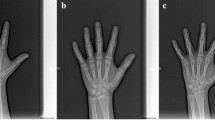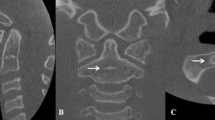Abstract
Objective:
The objective of this study was to compare three methods with which to determine the skeletal maturity of children.
Materials and Methods:
The methods were Greulich & Pyle’s atlas method based on hand-wrist radiographs (1959), and the cervical vertebrae methods based on lateral cephalograms of Lamparski (1972) and San Roman et al. (2002). We evaluated hand-wrist radiographs and the lateral cephalograms of 392 children (195 girls and 197 boys age 7–18). The morphology of the second (C2), third (C3) and fourth (C4) cervical vertebrae was assessed and the stage of skeletal maturity determined along with chronological age.
Results:
Our results revealed a significant correlation (p ≤ 0.05) between the skeletal maturity of the cervical vertebrae and the skeletal maturity of the hand. The correlation coefficients between the skeletal maturity of the cervical vertebrae and chronological age were obviously lower. The correlation coefficients were higher when using the method of San Roman et al. (2002) rather than Lamparski’s method (1972).
Conclusion:
Our results show that in assessing skeletal maturity, the lateral cephalogram can replace the hand-wrist radiograph, thus reducing the patient’s exposure to radiation.
Zusammenfassung
Ziel:
Ziel dieser Studie war es, drei Methoden miteinander zu vergleichen, die die skelettale Reife bei Kindern bestimmen.
Material und Methodik:
Verglichen wurden die auf Handröntgenaufnahmen basierende Atlasmethode von Greulich & Pyle (1959) und die auf Fernröntgenseitenaufnahmen basierenden Halswirbelmethoden von Lamparski (1972) und San Roman et al. (2002). Die Handröntgenaufnahmen und Fernröntgenseitenaufnahmen von 392 Kindern (195 Mädchen und 197 Jungen im Alter von 7–18 Jahren) wurden ausgewertet. Die Morphologie des zweiten (C2), dritten (C3) und vierten (C4) Halswirbelkörpers wurde beurteilt und die Phase der skelettalen Reife sowie das chronologische Alter bestimmt.
Ergebnisse:
Die Studie zeigte, dass ein signifikanter Zusammenhang (p ≤ 0,05) zwischen der skelettalen Reife der Halswirbel und der skelettalen Reife der Hand besteht. Die Korrelationskoeffizienten zwischen der skelettalen Reife der Halswirbel und dem chronologischen Alter waren deutlich niedriger. Die Korrelationskoeffizienten bei Anwendung der Methode nach San Roman et al. (2002) waren höher als bei der Methode nach Lamparski (1972).
Schlussfolgerung:
Die Ergebnisse belegen, dass in der Bewertung der skelettalen Reife die Fernröntgenseitenaufnahme die Handröntgenaufnahme ersetzen kann, so dass zusätzliche Röntgenbelastungen vermieden werden könnten.
Similar content being viewed by others
References
Björk A, Helm S. Prediction of the age of maximum puberal growth in body height. Angle Orthod 1967;37:134–43.
Flores-Mir C, Burgess C A, Champney M, et al. Correlation of skeletal maturation stages determined by cervical vertebrae and hand-wrist evaluations. Angle Orthod 2006;76:1–5.
Dibbets JM, Trotman CA, van der Weele L Th, et al. Multiple linear regression as an analytical tool in cephalometric studies. Br J Orthod 1997;24:61–5.
Drücke CC. Vorstellung und Verifizierung einer modifizierten Methode zur dentalen Altersbestimmung. Eichung des dentalen und skelettalen Alters für Nord- und Mittelhessen. Med Diss Universität Marburg, 2003 (URL: http://archiv.ub.uni-marburg.de/diss/z2003/0492).
Gandini P, Maucini M, Andreani F. A comparison of hand-wrist bone and cervical vertebral analyses in measuring skeletal maturation. Angle Orthod 2006;76:984–9.
Garcia-Fernandez P, Torre H, Flores L, Rea J. The cervical vertebrae as maturational indicators. J Clin Orthod 1998;32:221–5.
Grave K, Brown T. Skeletal ossification and the adolescent growth spurt. Am J Orthod 1976;69:611–9.
Greulich W, Pyle S. Radiographic atlas of skeletal development of the hand and wrist. Second edition. Stanford, CA: Stanford University Press, 1959.
Groell R, Lindbichler F, Riepl T, et al. The reliability of bone age determination in central European children using the Greulich and Pyle method. Br J Radiol 1999;72:461–4.
Hägg U, Taranger J. The timing and duration of adolescent growth. Acta Odontol Scand 1980;38:57–67.
Hassel B, Farman A. Skeletal maturation evaluation using cervical vertebrae. Am J Orthod Dentofacial Orthop 1995;107:58–66.
Hellsing E. Cervical vertebral dimension in 8–11 and 15 year old children. Acta Odontol Scand 1991;49:207–13.
Lamparski DG. Skeletal age assessment utilizing cervical vertebrae. Master of Science thesis, University of Pittsburg, 1972.
Lamparski DG, Nanda SK. Skeletal age assessment utilizing cervical vertebrae. In: McNamara Jr. JA, Kelly KA, eds. Treatment timing: orthodontics in four dimensions. Craniofacial Growth Series Vol 39. The Department of Orthodontics and Pediatric Dentistry and the Center for Human Growth and Development. Ann Arbor, MI: The University of Michigan, 2002:171–82.
Mora S, Boechat MI, Pietka E, et al. Skeletal age determination in children of European and African descent: Applicability of Greulich and Pyle standards. Pediatr Res 2001;50:624–8.
Nanda SK. Some comments on estimation normal craniofacial growth. In: McNamara, Jr. JA, ed. Growth modification: what works, and what doesn’t, and why. Craniofacial Growth Series Vol 35. Center for Human Growth and Development, Ann Arbor, MI: The University of Michigan, 1999:323–56.
Pancherz H, Szyska M. Analyse der Halswirbelkörper statt der Handknochen zur Bestimmung der skelettalen und somatischen Reife. Inf Orthod Kieferorthop 2000;32:151–61.
San Roman P, Palma JC, Oteo MD, Nevado E. Skeletal maturation determined by cervical vertebrae development. Eur J Orthod 2002;24:303–11.
Stiehl J. Die Entwicklung der Halswirbel als Kriterium für die skelettale Reife: Vergleich mit der klassischen Methode der Handwurzelaufnahme. Med Diss Universität Marburg, 2007 (URL: http://archiv.ub.uni-marburg.de/diss/z2007/0825).
Uysal T, Ramoglu SI, Basciftci FA, Sari Z. Chronologic age and skeletal maturation of the cervical vertebrae and hand-wrist: Is there a relationship? Am J Orthod Dentofacial Orthop 2006;130:622–8.
Author information
Authors and Affiliations
Corresponding author
Rights and permissions
About this article
Cite this article
Stiehl, J., Müller, B. & Dibbets, J. The Development of the Cervical Vertebrae as an Indicator of Skeletal Maturity: Comparison with the Classic Method of Hand-wrist Radiograph. J Orofac Orthop 70, 327–335 (2009). https://doi.org/10.1007/s00056-009-9918-x
Received:
Accepted:
Published:
Issue Date:
DOI: https://doi.org/10.1007/s00056-009-9918-x




